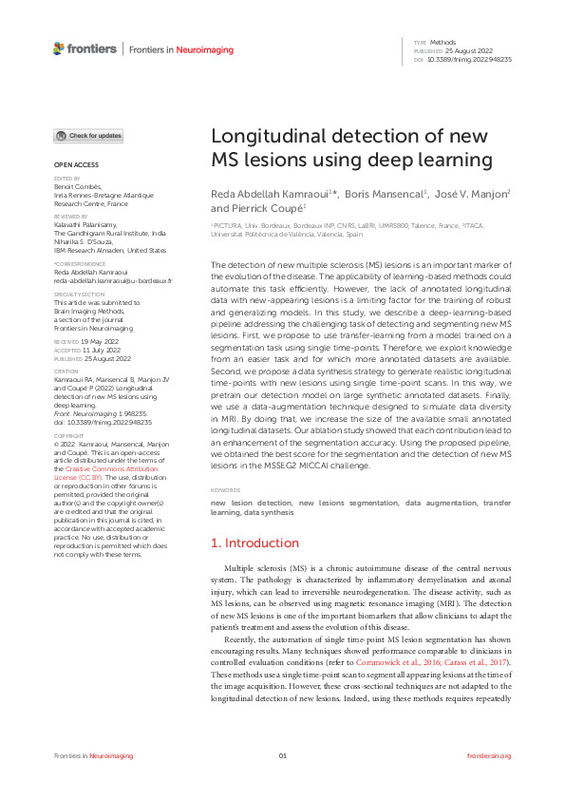JavaScript is disabled for your browser. Some features of this site may not work without it.
Buscar en RiuNet
Listar
Mi cuenta
Estadísticas
Ayuda RiuNet
Admin. UPV
Mostrar el registro sencillo del ítem
Ficheros en el ítem
| dc.contributor.author | Kamraoui, Reda Abdellah
|
es_ES |
| dc.contributor.author | Mansecal, Boris
|
es_ES |
| dc.contributor.author | Manjón Herrera, José Vicente
|
es_ES |
| dc.contributor.author | Coupé, Pierrick
|
es_ES |
| dc.date.accessioned | 2023-07-05T18:01:11Z | |
| dc.date.available | 2023-07-05T18:01:11Z | |
| dc.date.issued | 2022-08-25 | es_ES |
| dc.identifier.uri | http://hdl.handle.net/10251/194699 | |
| dc.description.abstract | [EN] The detection of new multiple sclerosis (MS) lesions is an important marker of the evolution of the disease. The applicability of learning-based methods could automate this task e ciently. However, the lack of annotated longitudinal data with new-appearing lesions is a limiting factor for the training of robust and generalizing models. In this study, we describe a deep-learning-based pipeline addressing the challenging task of detecting and segmenting new MS lesions. First, we propose to use transfer-learning from a model trained on a segmentation task using single time-points. Therefore, we exploit knowledge from an easier task and for which more annotated datasets are available. Second, we propose a data synthesis strategy to generate realistic longitudinal time-points with new lesions using single time-point scans. In this way, we pretrain our detection model on large synthetic annotated datasets. Finally, we use a data-augmentation technique designed to simulate data diversity in MRI. By doing that, we increase the size of the available small annotated longitudinal datasets. Our ablation study showed that each contribution lead to an enhancement of the segmentation accuracy. Using the proposed pipeline, we obtained the best score for the segmentation and the detection of new MS lesions in the MSSEG2 MICCAI challenge. | es_ES |
| dc.description.sponsorship | This study benefited from the support of the project DeepvolBrain of the French National Research Agency (ANR18-CE45-0013). This study was achieved within the context of the Laboratory of Excellence TRAIL ANR-10-LABX-57 for the BigDataBrain project. Moreover, we thank the Investments for the future Program IdEx Bordeaux (ANR-10-IDEX-03-02 and RRI IMPACT), the French Ministry of Education and Research, and the CNRS for the DeepMultiBrain project. This study has also been supported by the PID2020-118608RB-I00 grants from the Spanish Ministerio de Economia, Industria Competitividad. | es_ES |
| dc.language | Inglés | es_ES |
| dc.publisher | Frontiers Media S.A. | es_ES |
| dc.relation.ispartof | Frontiers in Neuroimaging | es_ES |
| dc.rights | Reconocimiento (by) | es_ES |
| dc.subject | New lesion detection | es_ES |
| dc.subject | New lesions segmentation | es_ES |
| dc.subject | Data augmentation | es_ES |
| dc.subject | Transfer learning | es_ES |
| dc.subject | Data synthesis | es_ES |
| dc.subject.classification | FISICA APLICADA | es_ES |
| dc.title | Longitudinal detection of new MS lesions using deep learning | es_ES |
| dc.type | Artículo | es_ES |
| dc.identifier.doi | 10.3389/fnimg.2022.948235 | es_ES |
| dc.relation.projectID | info:eu-repo/grantAgreement/AEI/Plan Estatal de Investigación Científica y Técnica y de Innovación 2017-2020/PID2020-118608RB-I00/ES/DESARROLLO DE UNA PLATAFORMA ONLINE PARA EL ANALISIS ANATOMICO Y HOLISTICO DEL CEREBRO BASADO IN DEEP LEARNING / | es_ES |
| dc.relation.projectID | info:eu-repo/grantAgreement/ANR//ANR-18-CE45-0013/ | es_ES |
| dc.relation.projectID | info:eu-repo/grantAgreement/ANR//ANR-10-LABX-57/ | es_ES |
| dc.relation.projectID | info:eu-repo/grantAgreement/ANR//ANR-10-IDEX-03-02/ | es_ES |
| dc.rights.accessRights | Abierto | es_ES |
| dc.contributor.affiliation | Universitat Politècnica de València. Escola Tècnica Superior d'Enginyeria Informàtica | es_ES |
| dc.description.bibliographicCitation | Kamraoui, RA.; Mansecal, B.; Manjón Herrera, JV.; Coupé, P. (2022). Longitudinal detection of new MS lesions using deep learning. Frontiers in Neuroimaging. 1:1-14. https://doi.org/10.3389/fnimg.2022.948235 | es_ES |
| dc.description.accrualMethod | S | es_ES |
| dc.relation.publisherversion | https://doi.org/10.3389/fnimg.2022.948235 | es_ES |
| dc.description.upvformatpinicio | 1 | es_ES |
| dc.description.upvformatpfin | 14 | es_ES |
| dc.type.version | info:eu-repo/semantics/publishedVersion | es_ES |
| dc.description.volume | 1 | es_ES |
| dc.identifier.eissn | 2813-1193 | es_ES |
| dc.relation.pasarela | S\484092 | es_ES |
| dc.contributor.funder | Agencia Estatal de Investigación | es_ES |
| dc.contributor.funder | Agence Nationale de la Recherche, Francia | es_ES |
| dc.contributor.funder | Centre National de la Recherche Scientifique, Francia | es_ES |
| dc.contributor.funder | Ministère de l'Enseignement Supérieur et de la Recherche, Francia | es_ES |








